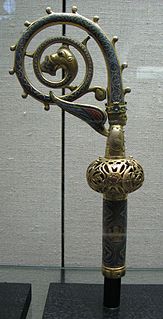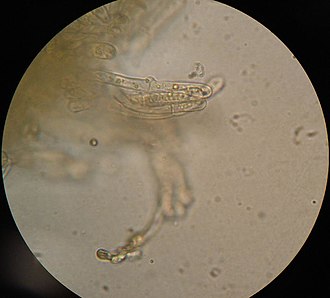
Basidiomycota is one of two large divisions that, together with the Ascomycota, constitute the subkingdom Dikarya within the kingdom Fungi. Members are known as Basidiomycetes. More specifically, Basidiomycota includes these groups: mushrooms, puffballs, stinkhorns, bracket fungi, other polypores, jelly fungi, boletes, chanterelles, earth stars, smuts, bunts, rusts, mirror yeasts, and Cryptococcus, the human pathogenic yeast. Basidiomycota are filamentous fungi composed of hyphae and reproduce sexually via the formation of specialized club-shaped end cells called basidia that normally bear external meiospores. These specialized spores are called basidiospores. However, some Basidiomycota are obligate asexual reproducers. Basidiomycota that reproduce asexually can typically be recognized as members of this division by gross similarity to others, by the formation of a distinctive anatomical feature, cell wall components, and definitively by phylogenetic molecular analysis of DNA sequence data.

Ascomycota is a phylum of the kingdom Fungi that, together with the Basidiomycota, forms the subkingdom Dikarya. Its members are commonly known as the sac fungi or ascomycetes. It is the largest phylum of Fungi, with over 64,000 species. The defining feature of this fungal group is the "ascus", a microscopic sexual structure in which nonmotile spores, called ascospores, are formed. However, some species of the Ascomycota are asexual, meaning that they do not have a sexual cycle and thus do not form asci or ascospores. Familiar examples of sac fungi include morels, truffles, brewer's yeast and baker's yeast, dead man's fingers, and cup fungi. The fungal symbionts in the majority of lichens such as Cladonia belong to the Ascomycota.

A hypha is a long, branching, filamentous structure of a fungus, oomycete, or actinobacterium. In most fungi, hyphae are the main mode of vegetative growth, and are collectively called a mycelium.

A sporangium is an enclosure in which spores are formed. It can be composed of a single cell or can be multicellular. All plants, fungi, and many other lineages form sporangia at some point in their life cycle. Sporangia can produce spores by mitosis, but in nearly all land plants and many fungi, sporangia are the site of meiosis and produce genetically distinct haploid spores.sporangia (singular-sporangium)

A basidium (pl. basidia) is a microscopic sporangium found on the hymenophore of fruiting bodies of basidiomycete fungi which are also called tertiary mycelium, developed from secondary mycelium. Tertiary mycelium is highly-coiled secondary mycelium – a dikaryon. The presence of basidia is one of the main characteristic features of the Basidiomycota. A basidium usually bears four sexual spores called basidiospores; occasionally the number may be two or even eight. In a typical basidium, each basidiospore is borne at the tip of a narrow prong or horn called a sterigma (pl. sterigmata), and is forcibly discharged upon maturity.

Zygomycota, or zygote fungi, is a former division or phylum of the kingdom Fungi. The members are now part of two phyla the Mucoromycota and Zoopagomycota. Approximately 1060 species are known. They are mostly terrestrial in habitat, living in soil or on decaying plant or animal material. Some are parasites of plants, insects, and small animals, while others form symbiotic relationships with plants. Zygomycete hyphae may be coenocytic, forming septa only where gametes are formed or to wall off dead hyphae. Zygomycota is no longer recognised as it was not believed to be truly monophyletic.

Neurospora crassa is a type of red bread mold of the phylum Ascomycota. The genus name, meaning "nerve spore" in Greek, refers to the characteristic striations on the spores. The first published account of this fungus was from an infestation of French bakeries in 1843.
Heterothallic species have sexes that reside in different individuals. The term is applied particularly to distinguish heterothallic fungi, which require two compatible partners to produce sexual spores, from homothallic ones, which are capable of sexual reproduction from a single organism.

A heterokaryon is a multinucleate cell that contains genetically different nuclei. Heterokaryotic and heterokaryosis are derived terms. This is a special type of syncytium. This can occur naturally, such as in the mycelium of fungi during sexual reproduction, or artificially as formed by the experimental fusion of two genetically different cells, as e.g., in hybridoma technology.

A basidiospore is a reproductive spore produced by Basidiomycete fungi, a grouping that includes mushrooms, shelf fungi, rusts, and smuts. Basidiospores typically each contain one haploid nucleus that is the product of meiosis, and they are produced by specialized fungal cells called basidia. Typically, four basidiospores develop on appendages from each basidium, out of these 2 are of one strain and other 2 of its opposite strain. In gills under a cap of one common species, there exist millions of basidia. Some gilled mushrooms in the order Agaricales have the ability to release billions of spores. The puffball fungus Calvatia gigantea has been calculated to produce about five trillion basidiospores. Most basidiospores are forcibly discharged, and are thus considered ballistospores. These spores serve as the main air dispersal units for the fungi. The spores are released during periods of high humidity and generally have a night-time or pre-dawn peak concentration in the atmosphere.

The dikaryon is a nuclear feature which is unique to certain fungi. Compatible cell-types can fuse cytoplasms (plasmogamy). When this occurs, the two nuclei of two cells pair off and cohabit without fusing (karyogamy). This can be maintained for all the cells of the hyphae by synchronously dividing so that pairs are passed to newer cells. In the Ascomycota this attribute is most often found in the ascogenous hyphae and ascocarp while the bulk of the mycelium remains monokaryotic. In the Basidiomycota this is the dominant phase, with most Basidiomycota monokaryons weakly growing and short-lived.

The Neighbour-Sensing mathematical model of hyphal growth is a set of interactive computer models that simulate the way fungi hyphae grow in three-dimensional space. The three-dimensional simulation is an experimental tool which can be used to study the morphogenesis of fungal hyphal networks.

Mating in fungi is a complex process governed by mating types. Research on fungal mating has focused on several model species with different behaviour. Not all fungi reproduce sexually and many that do are isogamous; thus, for many members of the fungal kingdom, the terms "male" and "female" do not apply. Homothallic species are able to mate with themselves, while in heterothallic species only isolates of opposite mating types can mate.

A sclerotium, is a compact mass of hardened fungal mycelium containing food reserves. One role of sclerotia is to survive environmental extremes. In some higher fungi such as ergot, sclerotia become detached and remain dormant until favorable growth conditions return. Sclerotia initially were mistaken for individual organisms and described as separate species until Louis René Tulasne proved in 1853 that sclerotia are only a stage in the life cycle of some fungi. Further investigation showed that this stage appears in many fungi belonging to many diverse groups. Sclerotia are important in the understanding of the life cycle and reproduction of fungi, as a food source, as medicine, and in agricultural blight management.

A chlamydospore is the thick-walled large resting spore of several kinds of fungi, including Ascomycota such as Candida, Basidiomycota such as Panus, and various Mortierellales species. It is the life-stage which survives in unfavourable conditions, such as dry or hot seasons. Fusarium oxysporum which causes the plant disease Fusarium wilt is one which forms chlamydospores in response to stresses like nutrient depletion. Mycelia of the pathogen can survive in this manner and germinate in favorable conditions.

A crozier is an anatomical feature of many fungi in the phylum Ascomycota that forms at the base of asci and looks like a hook-topped shepherd’s staff or stylized religious crosier. Croziers resemble and function similarly to clamp connections on the dikaryotic hyphae of Basidiomycota.

Dikarya is a subkingdom of Fungi that includes the divisions Ascomycota and Basidiomycota, both of which in general produce dikaryons, may be filamentous or unicellular, but are always without flagella. The Dikarya are most of the so-called "higher fungi", but also include many anamorphic species that would have been classified as molds in historical literature. Phylogenetically the two divisions regularly group together. In a 1998 publication, Thomas Cavalier-Smith referred to this group as the Neomycota.
The parasexual cycle, a process restricted to fungi and single-celled organisms, is a nonsexual mechanism of parasexuality for transferring genetic material without meiosis or the development of sexual structures. It was first described by Italian geneticist Guido Pontecorvo in 1956 during studies on Aspergillus nidulans. A parasexual cycle is initiated by the fusion of hyphae (anastomosis) during which nuclei and other cytoplasmic components occupy the same cell. Fusion of the unlike nuclei in the cell of the heterokaryon results in formation of a diploid nucleus (karyogamy), which is believed to be unstable and can produce segregants by recombination involving mitotic crossing-over and haploidization. Mitotic crossing-over can lead to the exchange of genes on chromosomes; while haploidization probably involves mitotic nondisjunctions which randomly reassort the chromosomes and result in the production of aneuploid and haploid cells. Like a sexual cycle, parasexuality gives the species the opportunity to recombine the genome and produce new genotypes in their offspring. Unlike a sexual cycle, the process lacks coordination and is exclusively mitotic.

A fungus is any member of the group of eukaryotic organisms that includes microorganisms such as yeasts and molds, as well as the more familiar mushrooms. These organisms are classified as a kingdom, separately from the other eukaryotic kingdoms, which by one traditional classification include Plantae, Animalia, Protozoa, and Chromista.

Dolipore septa are specialized dividing walls between cells (septa) found in almost all species of fungi in the phylum Basidiomycota. Unlike most fungal septa, they have a barrel-shaped swelling around their central pore, which is about 0.1–0.2 µm wide. This structure is typically capped at either end by specialized membranes, called "parenthesomes" or simply "pore caps".



















